Chapter 8
The Roman World
By Boundless
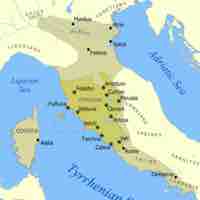
The Etruscans were a sixth to third century BCE Mediterranean civilization from whom the Romans derived a great deal of cultural influence.
Historians have no literature or original Etruscan religious or philosophical texts on which to base knowledge of their civilization, so much of what is known is derived from grave goods and tomb findings.
The Etruscan belief system was heavily influenced by other religions in the region and placed heavy emphasis on the divination of the gods’ wills to guide human affairs.
Myths surrounding the founding of Rome describe the city's origins through the lens of later figures and events.
For its first 200 years, Rome was ruled by seven kings, each of whom is credited either with establishing a key Roman tradition or constructing an important building.
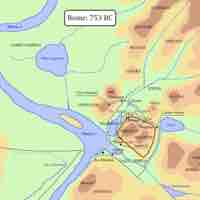
Multiple, overlapping hierarchies characterized Roman society, which was also highly patriarchal.
Romans overthrew the unpopular king Lucius Tarquinius Superbus and established a republican form of government after the public outcry arose as a result of the rape of Lucretia.

The Roman Republic was composed of the senate, a number of legislative assemblies, and elected magistrates.
The bulk of Roman politics prior to the first century BCE focused on inequalities among the orders.
Culture flourished during the Roman Republic with the emergence of great authors such as Cicero and Lucretius and the development of Roman relief and portraiture sculpture.

By the end of the mid-Republic, Rome had achieved military dominance on both the Italian peninsula and within the Mediterranean.
The first century BCE saw tensions between patricians and plebeians erupt into violence as the Republic became increasingly more divided and unstable.
Julius Caesar was a Late Republic statesman and general who waged civil war against the Roman Senate, defeating many patrician conservatives before he declared himself dictator.
Augustus rose to power after Julius Caesar's assassination through a series of political and military maneuvers, eventually establishing himself as the first emperor of Rome.
The Pax Romana, which began under Augustus, was a 200-year period of peace in which Rome experienced minimal expansion by military forces.
The Julio-Claudian emperors expanded the boundaries of the Roman Empire and engaged in ambitious construction projects, but met with mixed public reception due to their unique ruling methods.
Nero’s consolidation of personal power led to rebellion, civil war, and a year-long period of upheaval during which four separate emperors ruled Rome.
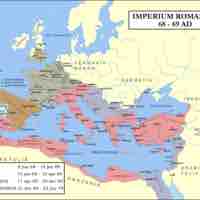
The Flavian dynasty, which began under the rule of Vespasian during the Year of the Four Emperors, is known for several significant historic, economic and military events that took place during their reign.
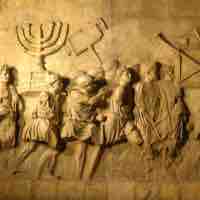
On the military front, the Flavian dynasty witnessed the siege and destruction of Jerusalem by Titus in 70 and substantial conquests in Great Britain under command of Gnaeus Julius Agricola between 77 and 83.
The eruption of Mount Vesuvius in 79 AD was one of the most catastrophic volcanic eruptions in European history, with several Roman settlements being obliterated and buried, and thereby preserved, under ash.
Under the Flavian dynasty, a massive building program was undertaken, leaving multiple enduring landmarks in the city of Rome, the most spectacular of which was the Flavian Amphitheatre, better known as the Colosseum.

Domitian, the last of the Flavian emperors, was a ruthless autocrat who develop many enemies, some of whom eventually assassinated him, giving rise to the long-lived Nerva–Antonine dynasty.
The Golden Age of Rome was a period of prosperity that fell under the "Five Good Emperors" of the Nerva-Antonine Dynasty: Nerva, Trajan, Hadrian, Antoninus Pius, and Marcus Aurelius.
The Nerva-Antonine dynasty saw the greatest military expansion in Roman history, leading the empire to attain its maximum territorial extent.
Emperor Hadrian, among other Nerva-Antonine emperors, patronized the arts, held public festivals, and influenced the culture of Rome and beyond.
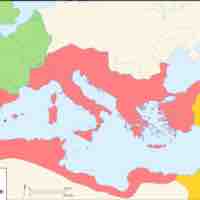
The Crisis of the Third Century was a period in which the Roman Empire nearly collapsed under the combined pressures of invasion, civil war, plague, and economic depression.
Facing the pressures of civil war, plague, invasion, and economic depression, Diocletian was able to stabilize the Roman empire for another hundred years through economic reform and the establishment of the Tetrarchy.
Though the early Christians were persecuted under emperors such as Nero and Diocletian, the religion continued to thrive and grow, eventually becoming the official religion of the Roman Empire under Constantine.
Constantine the Great was a Roman Emperor from 306 to 337 AD who adopted Christianity and declared it the religion of the Roman Empire.
Constantine built a new imperial residence in Byzantium and renamed the city Constantinople after himself, which would later become the capital of the Empire for over one thousand years.
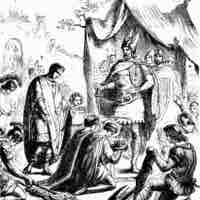
The Fall of the Western Roman Empire was the period of decline in the Western Roman Empire in which it disintegrated and split into numerous successor states.